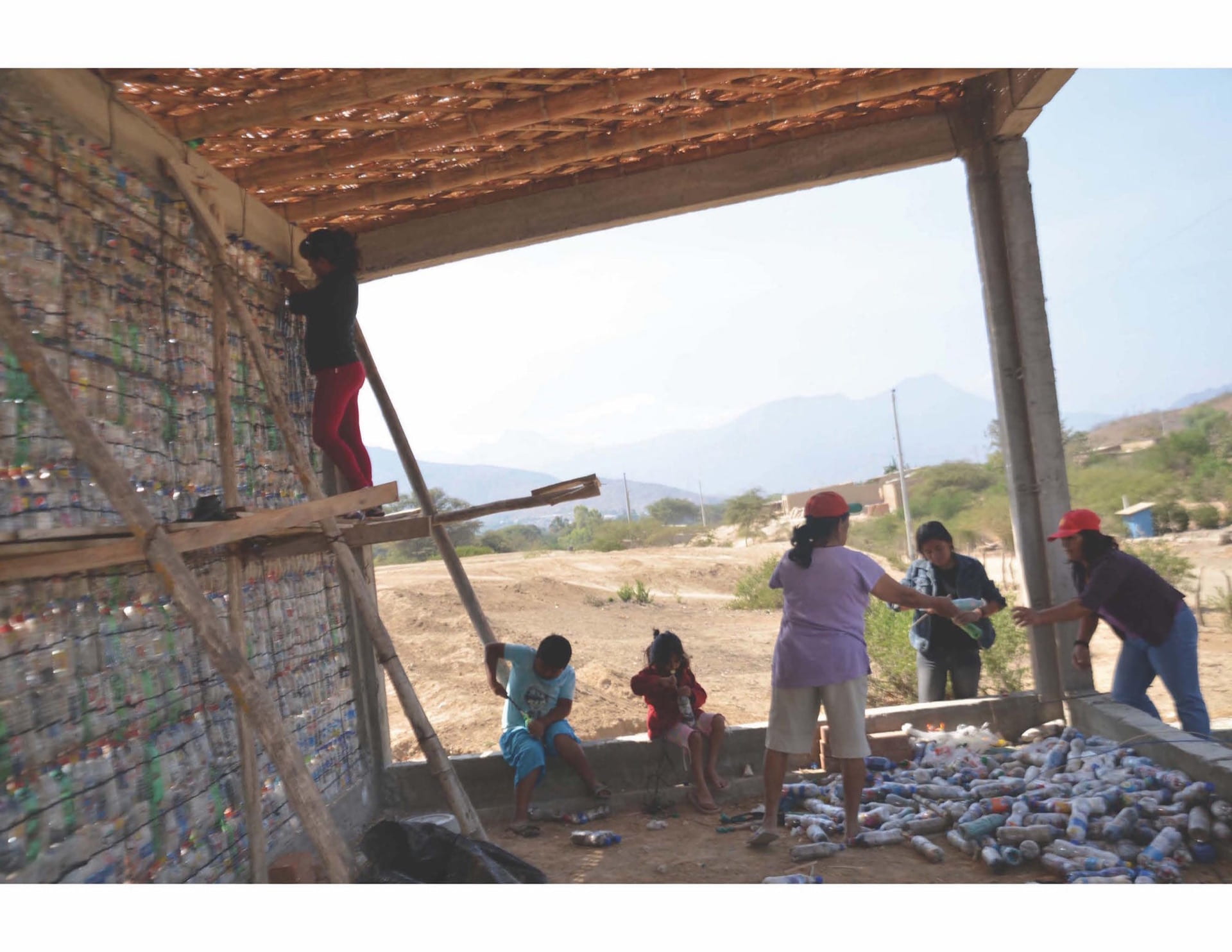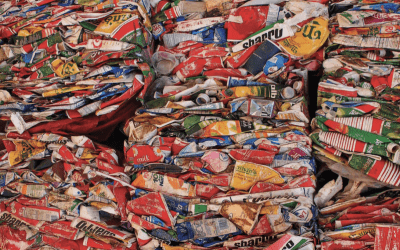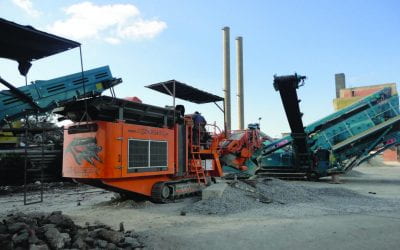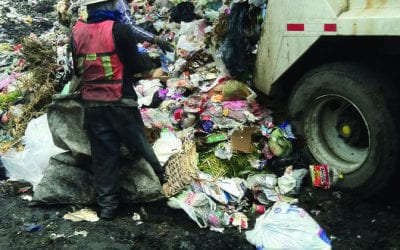Trash into Treasure
Building Up by Throwing Out in Chongoyape, Peru
In a town in northern Peru, a community has stuffed trash into 7,000 half-liter plastic bottles, also known as eco-bricks, and built a library. The town has no sanitary landfill and little knowledge of trash management. Yet residents have managed to create Peru’s first eco-brick building out of one metric ton of inorganic garbage, an accomplishment that owes its success to community participation and the cooperation of many organizations.
Comunidad Campesina Muchik Santa Catalina de Chongoyape, with 6,000 residents, is located in the Chancay valley between the coast and the Andes mountains. The people there earn a living mainly through agriculture and live in the middle of one of the largest dry tropical forests in the world. This is where I, Tina Montalvo, a native Marylander, spent the last three years as a Peace Corps Volunteer and member of Peace Corps Peru’s environment program, helping Chongoyape to learn and adapt to environmentally friendly living practices.
I was introduced to the eco-brick concept in 2010, when I saw an article in The Peace Corps Times about how volunteers such as Laura Kutner (Guatemala, 2008–2010) and Returned Peace Corps Volunteer Jonathan Miller (Guatemala, 2006–2008) had constructed eco-brick schools with the help of organizations called Pura Vida and Hug it Forward.
In July 2011, I began to introduce the idea to my own community and to local organizations such as CIPDES (Center for the Research and Promotion of Sustainable Development) Ayuda en Acción, ACOTURCH (Association for the Conservation of the Environment and Sustainable Tourism, Chaparrí) and Ultimate Voyages. Together we developed plans to start the project with the volunteer group Red Interquorum Chongoyape, an energetic bunch of 18- to 30-year-olds. They helped me visit local schools to talk about trash management, how to make an eco-brick and how to set up a bottle drive involving the six primary schools in the community. The success of the bottle drive was less than we hoped for, given the residents’ unwillingness to give up their plastic bottles, which they could sell to the local chatarrero, a.k.a. “Junk Man,” for a profit of .50 soles (about $0.16) per kilo.
Then I met a very driven college business student, Jessica Idrogo Mestanza, at the Santo Toribio of Mogrovejo Catholic University. Jessica helped to organize a contest in two secondary schools to collect plastic bottles in the capital city of Chiclayo. We ended up with 14,500 plastic bottles that were transported back to the community to start the process of producing the eco-bricks we’d need for the project. Jessica also introduced me to María Teresa Montenegro, a professor in the university’s Architecture Department. We held another contest, this time involving architecture students in their final year of course work, who submitted building designs. The winner turned out to be a multi-use facility: library, theater and eco-museum.
We were then able to communicate with a local community development group within Scotiabank called Iluminando el Mañana (Illuminating the Future). The Scotiabank group, along with the organizations I’ve already mentioned, helped me carry out fundraising activities such as a raffle, a Gran Pollada Deportiva (buy a ticket in advance; show up at the event to claim your chicken dinner; eat, drink, dance and play soccer), and a benefit concert with a performance from a local musical group, Domo Ensamble. Every nuevo sol earned (as you’ve gathered by now, the nuevo sol is the Peruvian monetary unit) was matched by Scotiabank Canada, giving us approximately US$8,000 total. The overall cost of the building project was estimated at US$25,000. CIPDES and ACOTURCH generously committed to providing funds that would cover the difference.
FIRST THINGS FIRST
Our combined efforts amounted to another first in a community known for its firsts. In 2001, with the help of the renowned National Geographic photographer Heinz Plenge, Santa Catalina de Chongoyape dedicated 85,033 acres of dry forest to Peru’s first Area of Private Conservation, known as the Ecological Reserve Chaparrí—an area where the Andean spectacled bear roams freely and the critically endangered, endemic white-winged guan thrives. Sustainable ecotourism has helped mitigate deforestation, habitat destruction, the illegal hunting of endangered animals, and has created jobs and improved health and education in the community. A portion of the money generated through tourism in the reserve helps purchase school supplies and construct and maintain the health post in Las Colmenas and build new bathrooms in the primary school, Tierras Blancas, paying skilled laborers to construct the library.
Creating eco-bricks was another step forward in preserving a threatened ecosystem, a way of putting the community’s trash to use instead of burning it or discarding it in the street. Before the initiation of the project, virtually the entire community employed the litterbug strategy of trash disposal. A Peace Corps Volunteer, Matt West, who’d worked previously in the area, was able to install 60 trashcans in four towns; the municipality collected the trash every 15 days. But without a sanitary landfill, they were only moving the trash to another location and burning it there—at least the part of it not carried off by the wind to nest in trees or clutter hillsides or be eaten by the local livestock. In the past, trash management hadn’t been much of a problem because everything Chongoyapanos used was locally sourced and made of natural materials; with the onset of the global distribution of goods, however, packaging materials have now proliferated in the marketplace; plastic bags and junk food wrappers have become a huge contamination problem. Plastics take 500 to 1,000 years to decompose and are broken down into smaller particles only to leach directly into rivers, streams and oceans. It is said that these particles are found in higher concentrations than the natural plankton and sea microbes and are being consumed by humans and all other species, creating as yet unknown long-term health risks.
Through school contests, promotional events and town meetings, some 300 families learned the concept of the eco-brick and proceeded with the task of filling half of the 14,500 plastic bottles obtained in the contest in the capital city with clean and dry inorganic waste—litter, in other words. A single bottle can take up to 10 minutes to fill and even longer for young children, who made up much of our work force. School children, teachers, mothers and fathers sat in circles, singing, reminiscing, and gossiping; at the same time learning the importance of trash management as they produced thousands of eco-bricks. Campaigns to collect and wash glass bottles resulted in the 2,500 glass bottles used to create Muchik cultural designs—representing Santa Catalina de Chongoyape’s indigenous heritage—in the walls of the proposed structure.
BETA TESTING AND STRONG DEMON(S)
To test the stability of the eco-bricks, the community, assisted by a World Connect “Kids to Kids” grant, created four bird-watching benches at the Tinajones Reservoir in an area inhabited by many migratory and native waterfowl. An average of 18 eco-bricks went into the construction of each bench. Benches were placed at the vantage points from which tourists and townspeople most commonly enjoy the view. The materials used in the benches held up and allowed us to continue working toward the construction of the actual eco-brick building.
In a small rural town such as Comunidad Campesina Muchik Santa Catalina de Chongoyape, you wouldn’t expect to make short work of the job and most certainly we did not. We started construction in April 2013. We should have started much sooner, but the location of the building became a point of contention. There were plans to create an ecological park in the same area, so the townspeople wanted space to accommodate a health-food restaurant, stores where beekeepers and artisans could sell their products, and a church. Accordingly, we moved the stakes and string that marked the building’s footprint, only to be asked to return the next week and move them again—and the following week move them yet again. We moved the stakes five times, eventually moving them back to where they’d been in the first place. As a result of this process, community members learned that it’s important to give and receive feedback prior to the initiation of an activity instead of after the activity is already in progress and have since been able to better manage the planning of projects.
We broke ground on April 1 (no joke—April Fools Day!). During construction, many more obstacles arose. For example, we had to convince community members to interrupt a normal day of paid work and come to work without pay on the bottle building. Many meetings took place to resolve this issue. (There are always lots of meetings. Sometimes there’s a meeting at which nothing is decided except to schedule another meeting.) Slowly, community members began to understand the importance of the building and eventually they embraced the project. The agreement reached obligated each community member to dedicate two days of work to the building. However, the problems didn’t end there. We engaged in a long series of technical disputes on how to construct the walls. Some favored a “quadrant” approach—framing consisting of uniformly shaped quadrants formed by two columns and two beams. Others thought we should just imbed the eco-bricks in adobe—mud walls. Fortunately, the technical team of the NGO CIPDES assisted with advice and modifications and came up with an approach that was both structurally sound and aesthetically appealing.
The structure and base of the building were made of cement and iron rods to ensure stability and withstand natural disasters such as earthquakes and torrential El Niño rains. The eco-bricks were placed between sections of wire mesh and then covered with cement and plaster—a combination nicknamed “diablo fuerte” or “strong demon.” It takes about three layers of diablo to create a structurally solid wall, but parts were left open to allow visitors and community members glimpses of what lay underneath.
We inaugurated the building on December 17, 2013. The building—which measures 26.24 x 49.21 feet—was designed to house a library, an eco-museum and a theater, benefiting the community in a variety of ways:
1. By promoting solid waste management and ecological awareness through the construction of eco-bricks and the building itself.
2. By creating within the new library a literacy program that will increase critical thinking, reading, and writing skills in children and adults.
3. By enabling—through the implementation of the eco-museum section—hands-on science and cultural learning activities to help promote and sustain an environmentally aware outlook in the community.
4. By developing creativity, self-esteem and leadership skills in the children and adults who will utilize the theater section.
5. By standing as a living monument to community development and achievement through cooperation and thereby promoting further community development and cooperation.
6. By developing computer and information-technology skills via library resources.
7. By creating a new tourist attraction to boost the community’s economy.
Today, what stands in the middle of the town of Santa Catalina de Chongoyape is a great example of what a community can accomplish when everyone works toward a shared goal. The look of pride in the participants’ faces the day we inaugurated is something I will never forget. However, there is still much to be done to make this building a functioning, sustainable entity and to allow it to reach its full potential: the creation of cultural and environmental exhibits; the procurement of books, computers, tables, chairs, and equipment stands; and much more. The community is now working on a campaign to obtain the materials needed and continues to accept any and all donations.
In many respects the plastic bottle has become the evil poster child of environmental degradation. Imagine the satisfaction in seeing this lowly and despicable emissary of blight and pollution transformed into a building block for a humble but beautiful center for culture and learning. It’s as if, as they fill with refuse, the plastic bottles in equal measure empty themselves of the unsavory nature we’ve attributed to them.
Winter 2015, Volume XIV, Number 2
Tina Montalvo, a graduate from the environmental science biology track program from Towson University, worked in Peru for three years as a Peace Corps volunteer. For more on the project, see Facebook: Bibliotella Chaparri.
Charles Martin is a Peace Corps Response volunteer in Inkawasi, Peru, and a former volunteer in Perquín, El Salvador, and Callanca, Peru.
Related Articles
Garbage: Editor’s Letter
Religion is a topic that’s been on my ReVista theme list for a very long time. It’s constantly made its way into other issues from Fiestas to Memory and Democracy to Natural Disasters. Religion permeates Latin America…
Buenos Aires, Wasteland
English + Español
Walking down Avenida Juan de Garay last week, I passed a giant black trash bag that had ballooned and burst. Orange peels, tomatoes, candy wrappers…
First Take: Waste
Waste—its generation, collection and disposal—is a major global challenge in the 21st century. Cities are responsible for managing municipal waste. Solid…






